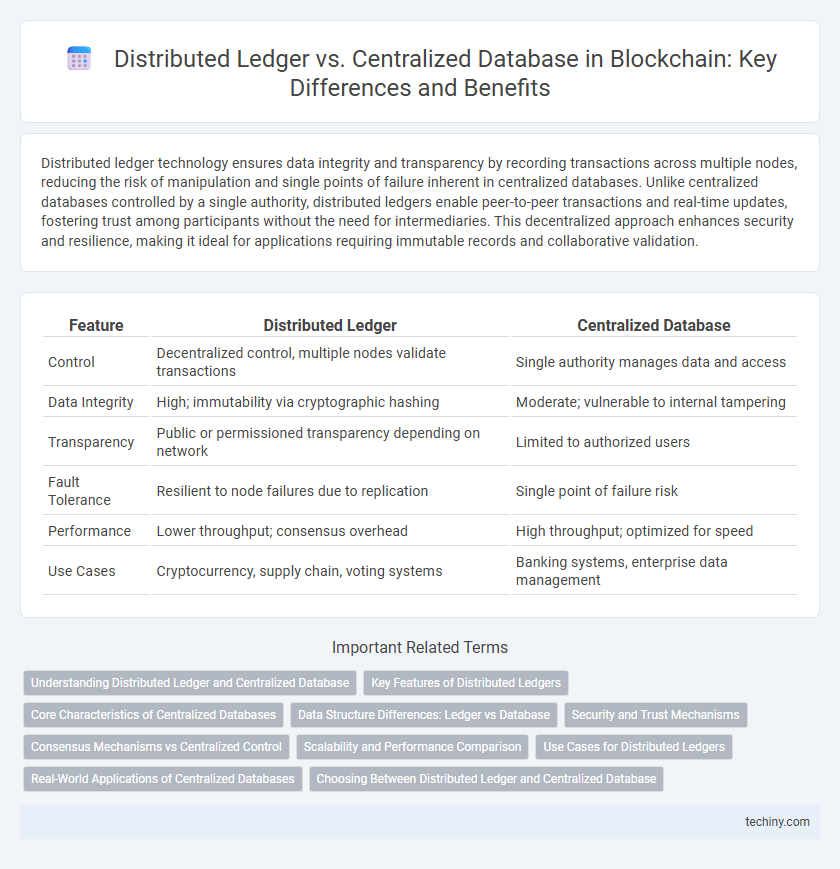Distributed ledger technology ensures data integrity and transparency by recording transactions across multiple nodes, reducing the risk of manipulation and single points of failure inherent in centralized databases. Unlike centralized databases controlled by a single authority, distributed ledgers enable peer-to-peer transactions and real-time updates, fostering trust among participants without the need for intermediaries. This decentralized approach enhances security and resilience, making it ideal for applications requiring immutable records and collaborative validation.
Table of Comparison
| Feature | Distributed Ledger | Centralized Database |
|---|---|---|
| Control | Decentralized control, multiple nodes validate transactions | Single authority manages data and access |
| Data Integrity | High; immutability via cryptographic hashing | Moderate; vulnerable to internal tampering |
| Transparency | Public or permissioned transparency depending on network | Limited to authorized users |
| Fault Tolerance | Resilient to node failures due to replication | Single point of failure risk |
| Performance | Lower throughput; consensus overhead | High throughput; optimized for speed |
| Use Cases | Cryptocurrency, supply chain, voting systems | Banking systems, enterprise data management |
Understanding Distributed Ledger and Centralized Database
A distributed ledger is a decentralized database maintained across multiple nodes, ensuring transparency, immutability, and enhanced security through consensus mechanisms. In contrast, a centralized database is managed by a single authority, offering faster transaction processing but with increased vulnerability to single points of failure and data manipulation. Understanding these fundamental differences is crucial for selecting the appropriate technology in blockchain applications.
Key Features of Distributed Ledgers
Distributed ledgers provide decentralized data storage across multiple nodes, ensuring transparency and immutability of transactions through cryptographic hashing. Unlike centralized databases, they eliminate single points of failure, enhancing security and fault tolerance. Consensus mechanisms validate entries, enabling trustless verification and reducing the need for intermediaries in blockchain ecosystems.
Core Characteristics of Centralized Databases
Centralized databases store data in a single location, managed by a central authority, enabling streamlined control and faster transaction processing. They rely on trust in the central administrator for data integrity and security, making them vulnerable to single points of failure and cyberattacks. Their architecture supports high efficiency for read/write operations but limits transparency and immutability compared to distributed ledgers.
Data Structure Differences: Ledger vs Database
Distributed ledgers utilize a sequential, append-only data structure where each block links cryptographically to the previous one, ensuring immutability and transparency. Centralized databases rely on mutable tables with rows and columns, allowing direct data updates and deletions controlled by a central authority. The ledger's block structure enhances security through consensus mechanisms, while database tables prioritize efficient querying and flexible data modification.
Security and Trust Mechanisms
Distributed ledgers provide enhanced security through cryptographic consensus algorithms and decentralized validation, reducing the risk of single points of failure and unauthorized data manipulation compared to centralized databases. Centralized databases rely on a single authority for data integrity, making them more vulnerable to insider threats and cyberattacks. Blockchain technology's immutable audit trail and consensus-driven trust mechanisms create a transparent, tamper-resistant environment that strengthens trust among network participants.
Consensus Mechanisms vs Centralized Control
Distributed ledgers rely on consensus mechanisms such as Proof of Work, Proof of Stake, or Byzantine Fault Tolerance to validate transactions across multiple nodes, ensuring data integrity without a central authority. Centralized databases depend on a single trusted entity to control and verify data, creating a potential single point of failure and reduced transparency. Consensus algorithms enable decentralized control and resilience in distributed ledgers, contrasting with the hierarchical management found in centralized database architectures.
Scalability and Performance Comparison
Distributed ledgers offer enhanced scalability by enabling multiple nodes to process transactions simultaneously, reducing bottlenecks typical in centralized databases. However, consensus mechanisms in distributed ledgers can introduce latency, impacting transaction throughput compared to the high-speed processing capabilities of centralized systems. Centralized databases excel in raw performance due to streamlined control, but they lack the fault tolerance and decentralization benefits that boost scalability in blockchain networks.
Use Cases for Distributed Ledgers
Distributed ledgers enable transparent and tamper-resistant record-keeping, making them ideal for supply chain management by improving traceability and reducing fraud. Financial services leverage distributed ledgers for faster settlement times, enhanced security, and reduced reliance on intermediaries. Use cases also extend to identity verification, secure voting systems, and decentralized applications, where trustless and immutable data management is critical.
Real-World Applications of Centralized Databases
Centralized databases dominate industries like banking, e-commerce, and healthcare by providing fast transaction processing and easy data management within a single authority. These systems enable real-time inventory tracking, customer relationship management, and secure financial record-keeping, supporting operational efficiency in organizations such as Amazon, JPMorgan Chase, and hospital networks. Their centralized control allows for straightforward data governance and compliance with regulatory standards critical to sectors like finance and healthcare.
Choosing Between Distributed Ledger and Centralized Database
Choosing between a distributed ledger and a centralized database depends on factors like transparency, security, and control requirements. Distributed ledgers offer decentralized validation and tamper-resistant records ideal for trustless environments, while centralized databases provide faster transaction processing and simpler management suited for controlled, internal systems. Enterprises prioritize scalability and consensus mechanisms in distributed ledgers versus performance and access control in centralized databases.
Distributed Ledger vs Centralized Database Infographic

 techiny.com
techiny.com